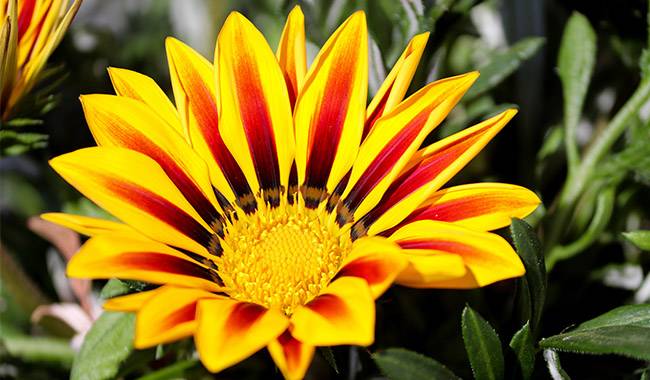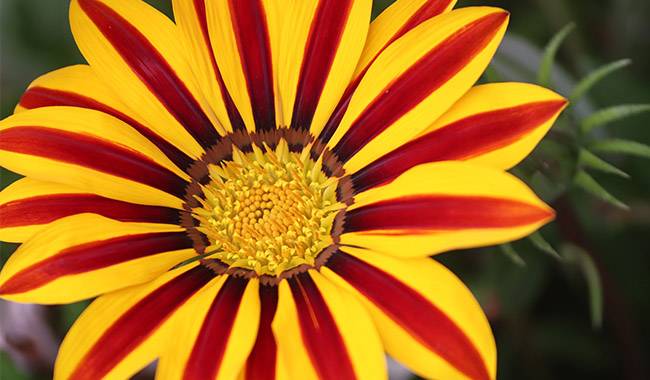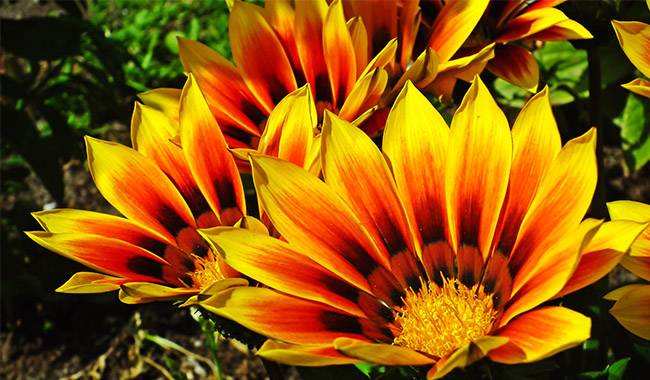
The stately and solemn African Daisies are the largest and most original of the aster family. This plant appeals to lovers of geometric and modern patterns in pots. Although African Daisies seem to be a real star on streets, balconies, and patios, it is virtually unknown as a house plant. However, of all the colorful and stylish annuals, the most suitable for indoor cultivation is African Daisies. although it has its own variables and requirements, it is not difficult to get it to bloom in grand style. This is the only way to protect the fall-flowering shrub. You will learn How to Grow and Care for African Daisies at Home in the ThumbGarden article.
Characteristics Of African Daisies Plants
The indoor career of African Daisies is mainly due to the desire to keep the shrub blooming until frost and to extend its flowering period into winter as well. These flowers do not stop blooming even in the late fall. If these plants are removed from the garden and placed in pots in a winter garden, greenhouse or room, then the beauty of the magical afternoon daisy can be enjoyed for months to come.
Those who have ever seen the beautiful African Daisies in a room format cannot resist growing them. This plant is especially beautiful in summer when it grows and blooms in rooms and balconies as well. But more and more often African Daisies appear on the list of summer and perennial plants, not only for the garden but also for indoor use.
African Daisies is often touted as one of the wonders of breeding, an artificially bred plant that is not found in nature. But species of African Daisies are an integral part of the South African flora.
Although these fascinating plants are primarily found in gardens as annuals, lobelia is still perennial herbs that, under the right conditions, can both overwinter and bloom the following year.
African Daisies are stemless perennial herbaceous plants. They develop a compact root rosette with large flowers emerging from the center of the rosette and growing on sturdy pedicels.
Compared to other Asteraceae, African Daisies are small in size and therefore particularly suitable for transfer to pots. Even in the garden, the flowers of African Daisies do not exceed 12 inches (30.4 cm) in height and remain very compact and modest. It is characterized by surprisingly strong rhizomes with long taproots that require a special selection of planting containers.
Their long lance-shaped, polymorphic, often changing into long pinnate and partially pinnate, variegated leaves are very striking even in a bush. Dark green, always looking fresh and dazzling, they surprised with their rather stiff texture and reversed silvery side, which seems too unexpected for the plant.
The contrast between the smooth outer side of the leaves and the pubescent underside is quite original. African Daisies look attractive even when not in flower and contrast well with any other houseplant.
How Do African Daisies Bloom Indoors?

The European name “Noonday Gold” best describes the appearance of this amazing plant. It evokes the sun and the brightest colors of a sunny garden. The flowers open at noon. It is as if they have absorbed all its color.
The botanical name of African Daisies is often used as a direct transcription of African Daisies, although most florists know the plant by its softer name.
African Daisies produces solitary basket-like inflorescences on sturdy, erect, stiff flowering stems. The latter develop not from the center of the rosette but from the leaf axils so that the flowers are evenly spaced in the rosette and are very attractive.
Like all African Daisies plants, the basket of African Daisies consists of a beautiful dense center with small tubular flowers of a very warm yellow-orange, almost classic gold color, and several lance-shaped rows of large African Daisies that form a bright circle around the golden midrib.
The spots or smears on each petal look like rays highlighting the golden center, giving an aesthetic appearance. the inflorescence of African Daisies can reach 3 inches (7.6 cm) in diameter. For such a small plant, they seem huge.
The color range of African Daisies includes warm tones reminiscent of sunny summer colors. Variations of white, light yellow, yellow, orange, red up to various shades of brown, and the deepest and most intense almost black create intricate patterns of color.
The dark purple-brown spots at the base of African Daisies give a graphic rigor, although many African Daisies cultivars lack this feature. Goldenrod seems to glow on the windowsill.
This plant is capable of endless flowering. Even potted African Daisies usually do not bloom until mid-summer. Only when the plant is exhausted or suffers from a lack of light does it stop flowering. In the garden, they can bloom until frost, and with proper care, they can enjoy blooming indoors until mid-autumn.
Even indoors, the plant does not lose its ability to bloom only on sunny days. African Daisies only reveal their brilliant daisy flowers in bright light and shut down at night or on cloudy days.
After flowering, African Daisies produces very beautiful, densely pubescent seed pods.
Species And Varieties Of African Daisies Plants Indoors
Several varieties of Gazania are grown in gardens, although the lesser variety of the original wild or natural African species has now almost completely replaced the hybrid varieties.
However, only Gazania (Gazania x hybrida, or Gazania hybrids) is considered an established indoor and container plant. These are compact cultivars, up to 12 inches (30.4 cm) tall, with linear or palmately dissected leaves, most commonly reversed silvery leaves and inflorescences up to 3 inches (7.6 cm) in diameter, that flower in mid-summer.
There are many varieties of this versatile plant, mainly represented by ultra-hardy hybrids, which can be selected purely according to personal taste. The choice is based on the color of the inflorescence – degree of mottling, shade, size of the flower basket.
If you want to use African Daisies as perennials, you can also bring other varieties into the room.
Gazania linearis is a beautiful, declining species with firm, bright leaves with white pubescence on the back and golden-brown baskets of flowers that don’t open until August.
Gazania rigens is a beautiful perennial with short branches, dense, incised leaves, and medium yellow-orange baskets reminding you of the sun, appearing on the shrub as early as June.
Growing Conditions Of African Daisies Plants Indoors

The conditions and care must be the same for both African Daisies indoors, which bloom for a surprisingly long time and can even be enjoyed in winter if done right, and African Daisies in the garden, which are only moved into the room when the first frost arrives.
Light and temperature are key in growing this plant indoors. Unless you can expose African Daisies to bright light and provide additional light, or move it on cloudy days, it will not be successful.
Although the idea of growing African Daisies in a purely indoor form was born out of a desire to preserve them through the winter when frost is too harsh for African Daisies, indoor African Daisies are therefore divided into two categories.
- True houseplants, originally grown for indoor use.
- Garden and houseplants that are moved indoors in the fall to maintain or prolong flowering.
The care of both types of indoor African Daisies should be the same, and the growing conditions of the crop should be the same.
A. Lighting and placement
Being a light-loving plant itself, it will not grow and bloom properly even in the lighted penumbra of the room format. Only a windowsill is suitable for it – the brighter the windowsill, the better.
Southern windows and bright balconies are the only options for indoor African Daisies and plants that have been moved into the room from the garden. As fall approaches, it is important to respond to changes in light at the right time in order to keep indoor African Daisies that were originally grown in pots blooming.
African Daisies in full bloom should be illuminated on cloudy days. do the same for those plants brought in from the garden for winter blooming.
African Daisies look great on the kitchen windowsill where the plants can be fully appreciated. They are also perfect for decorating craft corners and children’s rooms. Their beautiful baskets are perfect for dining rooms and balconies.
African Daisies can be planted not only as individual shrubs in individual pots but also in the same container as other herbaceous plants.
B. Temperature control and ventilation
African Daisies are very fond of heat and will only be comfortable in temperatures above 68 °F (20°C). An indoor environment will suit them well, but these unique plants are not afraid of heat either.
If the temperature exceeds 77 °F (25°C), the staphylococci’s need for fresh air increases. Overwintering is a relative term. The plant is usually simply discarded after it has finished flowering. However, if the right conditions are created, it does not stop at all in late summer or early autumn but can cover the whole winter.
For African Daisies still in bloom, temperatures should not drop below 50 °F (10 °C), but rising above 59 °F (15 °C) is also undesirable. Lower temperatures will prolong the blooming period.
African Daisies left in pots can be displayed on the balcony or, if possible, taken out into the garden. They like fresh air and will not grow without proper air circulation around the shrub. In hot weather, only fresh air can compensate for the discomfort of indoor conditions.
A unique feature of African Daisie’s is their resistance to drafts and wind. This plant can cope with all kinds of conditions and is not even afraid of open balconies at high altitudes, which together with their heat resistance is certainly a great advantage.
How To Care For African Daisies Plants At Home
Protecting the plant from overwatering, careful maintenance, careful observation of light, and moderate fertilization are all you need to grow African Daisies in pots. Whether they are grown only in containers or spend the summer in the garden, they are still a less demanding crop and still very hardy.
A. Watering and air humidity
Indoor African Daisies also retain some of their preference for drought. It does not tolerate wet substrates but will stop flowering if the substrate is completely dry. Avoid watering too much and water pooling in the trays.
The watering schedule for this plant is very specific: from the time it starts actively growing and planted in the main container until the first flowers start to open, it needs a high substrate moisture level and more drying after flowering.
As a houseplant, water only after the top layer of soil has dried out before flowering and the middle layer of soil has started to bloom. Even in summer, do not water this plant more than twice a week. A small amount of light watering is better than overly generous watering.
There is no need to add air humidity for African Daisies. These plants tolerate dryness well; conversely, they will suffer in an overly humid environment. When choosing a location for these flowers, place them away from moisture-loving plants. The heat of the tsundere plant is not compensated by humidity, but by exposure to fresh air.
B. Fertilizer and fertilizer composition
Like any lush summer and perennial plant that does not change its horticultural habits, indoor African Daisies like to be fertilized fairly frequently. It is best to fertilize plants at a frequency of 10-12 days, but only during the blooming period.
Start feeding 3 weeks after planting or transplanting with half the normal amount, then apply the normal amount from the germination stage.
Fantasies like to use special fertilizers for plants that bloom beautifully. Normal fertilizers do not bring out the beauty of the plant and can cause leaf growth that can interfere with flowering. You can also use special preparations during germination to increase the size of the inflorescence.
C. Pruning and shaping African Daisies
The only measure that needs to be taken is to cut off the faded inflorescences. The baskets quickly turn a faded tan color, so it is easy to spot the right time. The entire peduncle is cut off. If the inflorescence is left on the plant for too long, flowering will stop.
The dried parts should be removed from the plant periodically. If the shrubs are kept until spring, pruning the shoots and cleaning will bring them back faster. Do not keep even partially dried leaves. If flower buds wilt, cutting them off quickly will stimulate the release of new flowers.
D. Transplants, containers, and substrates
For purely indoor African Daisies and plants grown for a single but as long-lasting flowering as possible, transplanting is not necessary. The following rules can be considered planting rules.
If you want to grow overwintered African Daisies as garden plants (or non-flowering indoor specimens that survive the spring), the plants should be replanted in fresh soil in the spring to stimulate growth and prepare them for a second flowering.
Once the warmth has stabilized, transplant these plants into the garden. The key rule is that the root ball should not be damaged during either planting or transplanting.
African Daisies need containers that are large enough. They have long roots and ideally are deep enough in the pot to develop properly. They swarm in large containers and look good in all-around pots.
African Daisies grow better in ceramic casseroles. But the key feature of the container should still be the large drainage holes.
The substrate for growing African Daisies should be permeable and coarse enough not to be compact, but many consider fertility to be a key feature. Any multipurpose quality substrate for summer or balcony vegetables will do, as will any multipurpose substrate for houseplants of complex composition.
When repotting plants, place a coarse drainage device in the bottom of the container. Ceramic shards, vermiculite, or expanded clay are best. Gradually fill in the soil, after which the plant with a firm root ball is placed on a small soil mat over the drainage opening. Do not allow contact with the roots; any, even the slightest, injury to long or short roots will result in the loss of the plant.
After planting and transplanting, leave the wallflower in a mild environment for 2-3 weeks to protect it from the direct effects of sunlight, heat, and drafts. If the plant is being transplanted from a garden, you should try to make the transition as mild as possible by placing African Daisies in an intermediate isolation area where the temperature and light are similar to those in the garden. Exposure to fresh air will help the plants suffer less during the relocation process.
E. Diseases, pests, and problems with growing African Daisies plants
Improper watering can have a major impact on the condition of African Daisies, as the roots and stems are quickly attacked by rot if the substrate is wet. African Daisies are particularly susceptible to gray rot, but other fungal infections are not uncommon. This requires the use of strong fungicides and immediate isolation.
However, they are almost resistant to pests, except for neglected shrubs.
African Daisies will suffer from aphids, slugs, and snails if they are moved out of the garden and into the fresh air for shelter.
F. Propagating African Daisies plants indoors
The main method of propagation, even for indoor African Daisies, is still cultivation from seed. Ready-made seedlings of this attractive member of the aster family are available early on. But it is not difficult to grow independently either.
Sow African Daisies in April, the extreme period in early May. plants can also be sown earlier if artificial extra light is available.
African Daisies can be grown in the standard way. Any general-purpose substrate with enough sand for high water permeability will do. It is best to sow the seeds on a uniform substrate and moisten it after sowing.
For African Daisies, do not sow seeds in a general container, but in small pots individually, row by row, one seed at a time. No picking is done for this plant.
Do not cover the seeds of this plant with more than 2 mm of soil. Only after covering, moisten the soil evenly with a fine spray gun.
Germinate under glass or film at 64 °F (18°C) or higher, ventilate daily to remove condensation, and moisten slightly if the substrate becomes dry.
You will have to wait a considerable amount of time for germination, but they will develop rapidly. Remove the mulch immediately by moving the crops to the brightest spot and shining them on a cloudy day.
Lowering the temperature below 59 °F (15°C) and using hard water are not allowed. As the plants grow and all the substrate in the container is used, African Daisies will be packed into the main pot and gently transferred.
Staying up until the crunching of spring can be used to divide them. The dry leaves are removed and the shrubs are divided into individual rosettes. They are planted out, treated with a growth stimulant, and placed in a soft environment with good light for rooting.
For any young African Daisies, avoid drafts, sudden changes in temperature, and direct sunlight on the shoots.







